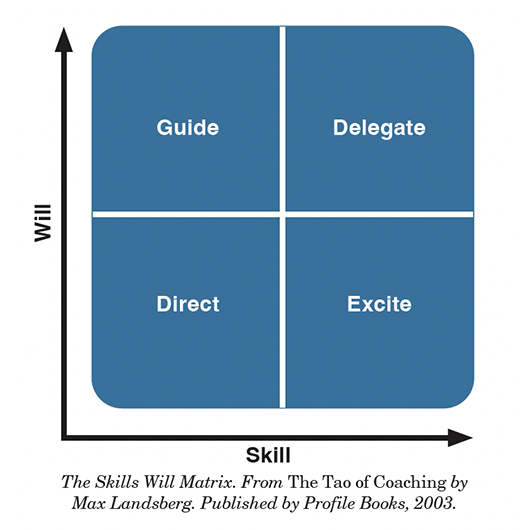How to be a better coach using the Skill Will Matrix
As a leader, you need to assess two things:
team members’ skill level for the task and their will to tackle it.
By Carolyn Smith, APR, TRA
As we head into Q4, the insurance industry is rocked by climate change, political upheavals, economic hurdles, and a tough market. Rates are up, underwriting is tighter, and renewal talks are tricky. Workloads are heavier, and placing new business is challenging.
Employees are feeling it—unmotivated and overwhelmed. The constant challenges and fast changes have drained morale. Staying focused and driven to generate revenue is tough, with burnout and frustration setting in.
It’s time to acknowledge these struggles and reignite the team’s motivation. Tackle these issues head-on to create a supportive, resilient work environment and achieve your agency’s revenue goals for the year.
How? Motivating and supporting a diverse group requires a nuanced approach that considers each team member’s needs, unique abilities, strengths, and goals: the Skill Will Matrix.
A tool for empathetic leadership
Imagine this: You’re coaching two team members, Anita and Patrick. Anita has experience and motivation, while Patrick is eager but new.
Both are tackling new projects and feeling the pressure. Anita finds your advice a bit patronizing, and Patrick can’t quite follow your suggestions. Clearly, it’s time to adjust your coaching style.
Enter the Skill Will Matrix. Popularized by Max Landsberg in his 1996 book, The Tao of Coaching, this tool offers a framework for assessing and adapting your leadership style to better support your team.
Coaching happens when someone needs help with a specific situation, issue, or task, e.g., “making a presentation to a large potential client,” not something too broad like “communication.” As a leader, you need to assess two things: team members’ skill level for the task and their will to tackle it.
- Skill is about experience, training, and understanding.
- Will is about desire, incentives, security, and confidence.
Get it right, and you’ll guide your team to enhanced success.

Crafting strategies for each quadrant
The matrix is divided into four quadrants, each suggesting a specific managerial strategy:
- High skill, high will: delegate approach
Quadrant 1 members are highly capable and self-motivated—your star performers. They are valuable assets to the team and organization. They thrive on autonomy and should be given challenging tasks that foster growth.
Crafting strategies for each quadrant
The matrix is divided into four quadrants, each suggesting a specific managerial strategy:
- High skill, high will: delegate approach
Quadrant 1 members are highly capable and self-motivated—your star performers. They are valuable assets to the team and organization. They thrive on autonomy and should be given challenging tasks that foster growth.
Strategy:
- Empower and provide growth opportunities.
- Encourage leadership roles and autonomy.
- Recognize and reward achievements.
- Offer challenges and responsibilities that align with their skills and motivation.
Star performers (high skill, high will) examples:
- Jerry, the top producer. He has extensive experience, a big book of business, and a proven track record of success in securing new business and retaining clients year after year. He consistently closes high-value deals with enthusiasm. He needs challenging tasks and opportunities for growth, such as leading strategic initiatives or mentoring new producers.
- Geneva, the star personal lines agent. She is high-performing and consistently meets or exceeds her targets, demonstrating exceptional knowledge and dedication without needing close supervision. To motivate her, recognize her achievements publicly and give her challenging projects that let her shine.
- High skill, low will: excite approach
Quadrant 2 members have the required skills but may be experiencing burnout or a lack of engagement. They have the potential to excel if motivated effectively. Identify what excites them and tailor their tasks accordingly. This might involve new responsibilities or roles that align better with their interests and strengths.
Strategy:
- Motivate, recognize achievements, or address underlying issues affecting motivation.
- Understand their interests and career goals.
- Provide clear goals and a sense of purpose.
- Consider role adjustments or challenges to reignite their enthusiasm.
Frustrated experts (high skill, low will) example:
- Isla, the bored account executive. She is a seasoned account manager who, despite having the expertise, feels demotivated due to repetitive tasks. Addressing her underlying concerns and providing new challenges can help reignite her passion. This could involve transitioning to a different role or leading client engagement initiatives.
- Zach, the jaded CSR. Zach is an experienced customer service representative who is feeling uninspired in his current role. Exploring new project opportunities or specialized responsibilities might reignite his motivation.
- Low skill, high will: guide approach
Quadrant 3 members are motivated and enthusiastic but do not possess the necessary skills to perform their roles effectively. They have the potential for growth.
Strategy:
- Invest in training and skill development.
- Provide mentorship and guidance.
- Set clear expectations and goals.
- Create opportunities for skill acquisition and growth.
Enthusiastic beginners (low skill, high will) examples:
- Josie, the new producer with imposter syndrome. She recently changed careers and now is an entry-level producer with a strong desire to contribute but lacking the skills for complex client consultations. Providing training and mentorship can help her grow into the role.
- Zeke, the enthusiastic claims associate. Zeke, a recent graduate joined the claims department with high motivation but limited technical skills. Investing in training programs can accelerate his development.
- Low skill, low will: direct approach
Quadrant 4 members may present challenges in terms of both skills and motivation. Their contribution may be limited, and their fit within the team should be assessed.
Strategy:
- Evaluate role fit and alignment with team goals.
- Provide clear expectations and consequences.
- Offer coaching and support if there is potential for improvement.
- Consider reassignment or alternative roles if necessary.
Struggling individuals (low skill, low will) examples:
- Chen, the insecure CSR. He is stressed about possible errors in documentation and afraid to talk to clients, fearful of providing misinformation. He needs direct support. Frequent check-ins, clear instructions, and incremental goals can help him gain confidence and improve his performance gradually.
- Zoe, the disengaged producer. She consistently underperforms, lacks motivation, dislikes making client visits, and demonstrates a poor fit with the team’s dynamics. A performance improvement plan or role realignment may be needed.
Pros and cons of the Skill Will Matrix
Implementing a Skill Will Matrix in your organization can be highly beneficial but, like any performance management tool, it has its downsides. Here are some advantages and disadvantages to help you determine if it’s suitable for your needs.
Pros:
Enhanced understanding of employee potential. The Skill Will Matrix helps you concentrate on your employees’ potential, including their ability to acquire new skills and adopt a more positive attitude. It also highlights their potential for leadership roles. By focusing on future possibilities rather than past performances, this matrix fosters a more optimistic approach to sales and performance management.
Customized talent development. The matrix allows for a tailored approach to talent development. Struggling employees can receive additional support, while top performers can enjoy the independence they desire. This customized support tends to increase employee satisfaction with management.
Improved communication and feedback. To accurately determine employees’ skill and will levels, a solid system of communication and feedback is necessary. The Skill Will Matrix encourages the creation of a structured performance management plan, enhancing the accuracy of skill and will assessments.
Cons:
Subjectivity and potential bias. There is a risk of subjectivity and bias in the assessment process. Evaluating an employee’s will can be challenging, and even with data, managers might rely on intuition. Additionally, you might misjudge an employee’s skill if performance goals are not appropriately set.
Continuous assessment and adjustments. The matrix requires ongoing assessments and frequent updates based on the latest data. This can be time-consuming, as administering and analyzing multiple assessments to track employee progress within the matrix demands significant effort. Performance management tools can streamline this process, but it remains labor-intensive.
Integration with other performance management tools. While the Skill Will Matrix is straightforward with its four quadrants, it cannot function independently. It needs to be part of a broader HR or performance management system that includes annual goals, feedback, and reviews to be truly effective.
By assessing these pros and cons, you can better decide whether the Skill Will Matrix aligns with your organization’s performance management strategy.
More than a tool
“I’ve seen firsthand how tailored training and development plans can significantly enhance employee engagement and retention,” says Heather Parsons, people and operations manager for The Insurance Market and HR consultant for IMHR. “Insurance agencies, in particular, operate in a dynamic and highly regulated environment where one-size-fits-all training programs fall short.
“By addressing the unique needs, career aspirations, and skill gaps of each individual,” she adds, “we can foster a more competent and motivated workforce. This personalized approach demonstrates that employees are valued, which in turn strengthens their commitment and loyalty to the organization.”
The Skill Will Matrix is more than a tool; it’s a mindset for empathetic leadership. By understanding where each team member stands in terms of skill and motivation, you can tailor your approach to support their growth effectively. This personalized strategy not only enhances individual performance but also contributes to a more cohesive and resilient team. Embrace the matrix, and watch your team thrive.
The author
Carolyn Smith, APR, TRA, chief training officer for Beyond Insurance, creates and delivers transformative programs, including the Trusted Risk Advisor certification, BIGN Producer Boot Camp, and Quest for Success, that have positively impacted the lives and careers of countless professionals. These programs help industry professionals build a career that they love and achieve the success they deserve.






